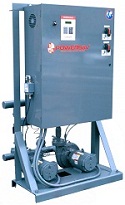| Printer Friendly (PDF) The most frequently asked question is “How do I specify the right motor for variable speed applications”? Let’s start by referring to NEMA, which is the National Electrical Manufacturers Association standards. NEMA does not use terms such as Inverter Duty, Inverter Rated, or Inverter Ready. These are marketing terms used by motor manufacturers. These are marketing terms used by motor manufacturers.Before discussing the standards, let’s examine the motors used in our industry. Motors used in applications, such as elevators or conveyer belts, experience constant torque loads. Some of these constant torque devices require motors that experience much more severe duty than our HVAC and Plumbing applications. Fans, blowers, and (my favorite) pumps are variable torque loads. As the speed drops, so does the load, so there is less strain on the motor due to work. When you go on the internet and find complicated motor specifications for drives, make sure you match the specification to the duty.
Here are the important points for use in our Industry. 1. Motor should be NEMA Design B with Class F insulation 2. Motor should be able to operate with a 10:1 speed reduction. 3. NEMA standard MG-1 2006 – Part 31.4.4.2 specifies voltage spikes over a time constant. The motors used on variable speed drives, for HVAC applications, should meet this section. 460/60/3 motors shall have an insulation system designed to operate at 1 1426 Volt spike for 0.1μS 4. NEMA standard MG-1 2006 – Part 31.4.4.3 has recently included suggestions to protect the motor from EDM (Electronic discharge machining), commonly called bearing fluting or wash boarding. Motor damage may be caused by the shaft currents created by the use of PWM inverters. Shaft grounding brushes or rings are suggested in this specification. Note that these protective devices must be specified and are not automatically included just because a motor is used with an inverter. If you are in the R. L. Deppmann territory of Michigan and Northern Ohio and would like us to review you motor and pump specifications CLICK HERE. |
 |
Disclaimer: R. L. Deppmann and it’s affiliates can not be held liable for issues caused by use of the information on this page. While the information comes from many years of experience and can be a valuable tool, it may not take into account special circumstances in your system and we therefore can not take responsibility for actions that result from this information. Please feel free to contact us if you do have any questions.
Archives – Click here for Past Articles

